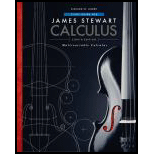
Study Guide for Stewart's Multivariable Calculus, 8th
8th Edition
ISBN: 9781305271845
Author: Stewart, James
Publisher: Brooks Cole
expand_more
expand_more
format_list_bulleted
Question
Chapter 16.8, Problem 1PT
To determine
To choose: The appropriate option for the statement “Let
Expert Solution & Answer
Want to see the full answer?
Check out a sample textbook solution
Students have asked these similar questions
The spread of an infectious disease is often modeled using the following autonomous differential equation:
dI
-
- BI(N − I) − MI,
dt
where I is the number of infected people, N is the total size of the population being modeled, ẞ is a constant determining the rate of
transmission, and μ is the rate at which people recover from infection.
Close
a) (5 points) Suppose ẞ = 0.01, N = 1000, and µ = 2. Find all equilibria.
b) (5 points) For the equilbria in part a), determine whether each is stable or unstable.
c) (3 points) Suppose ƒ(I) = d. Draw a phase plot of f against I. (You can use Wolfram Alpha or Desmos to plot the function, or draw the
dt
function by hand.) Identify the equilibria as stable or unstable in the graph.
d) (2 points) Explain the biological meaning of these equilibria being stable or unstable.
Find the indefinite integral.
Check
Answer:
7x
4 + 1x
dx
show sketch
Chapter 16 Solutions
Study Guide for Stewart's Multivariable Calculus, 8th
Ch. 16.1 - For F(x,y)=(x+y)i+(2x4y)j, which vector, a, b, c,...Ch. 16.1 - Prob. 2PTCh. 16.1 - Prob. 3PTCh. 16.1 - True or False: F(x,y)=2yi+2xj is conservative.Ch. 16.2 - A definite integral for C(x+y)ds, where C is the...Ch. 16.2 - True or False: The curve at the right appears to...Ch. 16.2 - A definite integral for CFdr, where F(x,y)=x2i+y2j...Ch. 16.2 - Prob. 4PTCh. 16.2 - Prob. 5PTCh. 16.3 - Prob. 1PT
Ch. 16.3 - Which curve is simple but not closed?Ch. 16.3 - Prob. 3PTCh. 16.3 - Prob. 4PTCh. 16.3 - Prob. 5PTCh. 16.4 - Prob. 1PTCh. 16.4 - Prob. 2PTCh. 16.4 - Prob. 3PTCh. 16.4 - Prob. 4PTCh. 16.5 - Prob. 1PTCh. 16.5 - Prob. 2PTCh. 16.5 - Prob. 3PTCh. 16.5 - True or False: div curl F = 0.Ch. 16.5 - Prob. 5PTCh. 16.5 - Prob. 6PTCh. 16.6 - Prob. 1PTCh. 16.6 - Prob. 2PTCh. 16.6 - Prob. 3PTCh. 16.6 - Prob. 4PTCh. 16.6 - Write an iterated integral for the area of that...Ch. 16.7 - Prob. 1PTCh. 16.7 - Prob. 2PTCh. 16.7 - Prob. 3PTCh. 16.8 - Prob. 1PTCh. 16.8 - Prob. 2PTCh. 16.8 - Let F(x, y, z) = zi + xj yk and the curve C be...Ch. 16.9 - Prob. 1PTCh. 16.9 - Prob. 2PT
Knowledge Booster
Learn more about
Need a deep-dive on the concept behind this application? Look no further. Learn more about this topic, calculus and related others by exploring similar questions and additional content below.Similar questions
- Find the indefinite integral. Check Answer: 7x 4 + 1x dxarrow_forwardQuestion 1: Evaluate the following indefinite integrals. a) (5 points) sin(2x) 1 + cos² (x) dx b) (5 points) t(2t+5)³ dt c) (5 points) √ (In(v²)+1) 4 -dv ขarrow_forwardFind the indefinite integral. Check Answer: In(5x) dx xarrow_forward
- Find the indefinite integral. Check Answer: 7x 4 + 1x dxarrow_forwardHere is a region R in Quadrant I. y 2.0 T 1.5 1.0 0.5 0.0 + 55 0.0 0.5 1.0 1.5 2.0 X It is bounded by y = x¹/3, y = 1, and x = 0. We want to evaluate this double integral. ONLY ONE order of integration will work. Good luck! The dA =???arrow_forward43–46. Directions of change Consider the following functions f and points P. Sketch the xy-plane showing P and the level curve through P. Indicate (as in Figure 15.52) the directions of maximum increase, maximum decrease, and no change for f. ■ 45. f(x, y) = x² + xy + y² + 7; P(−3, 3)arrow_forward
- EX-let d'be ametric on a vector space X induced from a norm hx and d defind by a Slab)= {od (a, if a = b (a,b)+is ab Show that cannot be induced froman norm on X. 2) let à be trivel metric show that I cannot be induced from an norm on X- 3) let M be closed subspace of anormed spacex Construct the space X/Mas a normed space. 4) let Mix be vector space of 2x3 matrices on R write with Prove convex set and hyper Plane of M 5) show that every a finite dimension subspace of anormed space is closed.arrow_forwardplease do #48arrow_forward43–46. Directions of change Consider the following functions f and points P. Sketch the xy-plane showing P and the level curve through P. Indicate (as in Figure 15.52) the directions of maximum increase, maximum decrease, and no change for f. ■ 45. f(x, y) = x² + xy + y² + 7; P(−3, 3)arrow_forward
arrow_back_ios
SEE MORE QUESTIONS
arrow_forward_ios
Recommended textbooks for you
 Calculus: Early TranscendentalsCalculusISBN:9781285741550Author:James StewartPublisher:Cengage Learning
Calculus: Early TranscendentalsCalculusISBN:9781285741550Author:James StewartPublisher:Cengage Learning Thomas' Calculus (14th Edition)CalculusISBN:9780134438986Author:Joel R. Hass, Christopher E. Heil, Maurice D. WeirPublisher:PEARSON
Thomas' Calculus (14th Edition)CalculusISBN:9780134438986Author:Joel R. Hass, Christopher E. Heil, Maurice D. WeirPublisher:PEARSON Calculus: Early Transcendentals (3rd Edition)CalculusISBN:9780134763644Author:William L. Briggs, Lyle Cochran, Bernard Gillett, Eric SchulzPublisher:PEARSON
Calculus: Early Transcendentals (3rd Edition)CalculusISBN:9780134763644Author:William L. Briggs, Lyle Cochran, Bernard Gillett, Eric SchulzPublisher:PEARSON Calculus: Early TranscendentalsCalculusISBN:9781319050740Author:Jon Rogawski, Colin Adams, Robert FranzosaPublisher:W. H. Freeman
Calculus: Early TranscendentalsCalculusISBN:9781319050740Author:Jon Rogawski, Colin Adams, Robert FranzosaPublisher:W. H. Freeman
 Calculus: Early Transcendental FunctionsCalculusISBN:9781337552516Author:Ron Larson, Bruce H. EdwardsPublisher:Cengage Learning
Calculus: Early Transcendental FunctionsCalculusISBN:9781337552516Author:Ron Larson, Bruce H. EdwardsPublisher:Cengage Learning

Calculus: Early Transcendentals
Calculus
ISBN:9781285741550
Author:James Stewart
Publisher:Cengage Learning

Thomas' Calculus (14th Edition)
Calculus
ISBN:9780134438986
Author:Joel R. Hass, Christopher E. Heil, Maurice D. Weir
Publisher:PEARSON

Calculus: Early Transcendentals (3rd Edition)
Calculus
ISBN:9780134763644
Author:William L. Briggs, Lyle Cochran, Bernard Gillett, Eric Schulz
Publisher:PEARSON

Calculus: Early Transcendentals
Calculus
ISBN:9781319050740
Author:Jon Rogawski, Colin Adams, Robert Franzosa
Publisher:W. H. Freeman


Calculus: Early Transcendental Functions
Calculus
ISBN:9781337552516
Author:Ron Larson, Bruce H. Edwards
Publisher:Cengage Learning
Introduction to Triple Integrals; Author: Mathispower4u;https://www.youtube.com/watch?v=CPR0ZD0IYVE;License: Standard YouTube License, CC-BY